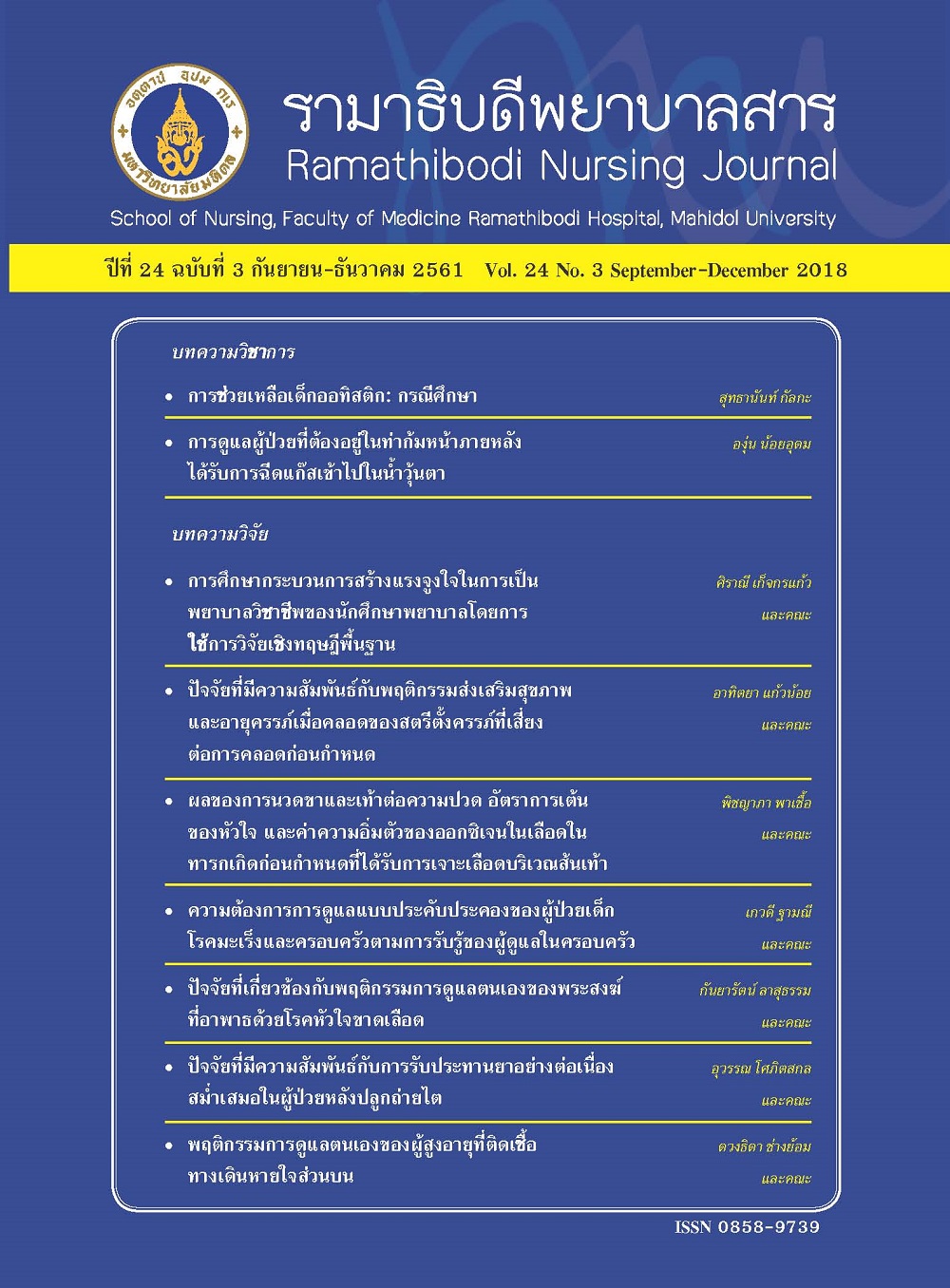Caring for Children with Autism Spectrum: A Case Study
Main Article Content
Abstract
Autism spectrum disorder (ASD) is a complex developmental condition that involves persistent challenges in social interaction, speech, and nonverbal communication, as well as restricted/repetitive behaviors. The Diagnostic and Statistical Manual of Mental Disorders (DSM-V) classifies severity levels of ASD into three levels: Level 1 requiring support, Level 2 requiring substantial support, and Level 3 requiring very substantial support. However, the severity level of autism spectrum disorder could change over time with the child’s development and the care provided for them. Current approaches to support autistic children include 1) assistance from medical professionals, 2) empowerment of family, 3) collaboration with school personnel, and 4) enhancing the abilities of autistic children. Therefore, having knowledge and understanding of the initial signs of ASD are important factors for parents to detect the disorders early, as earlier interventions would be expected to improve the development of children with autism spectrum disorder.
Keywords: Autism spectrum disorder, Severity levels, Developmental promotion
Article Details
บทความ ข้อมูล เนื้อหา รูปภาพ ฯลฯ ที่ได้รับการตีพิมพ์ในรามาธิบดีพยาบาลสาร ถือเป็นลิขสิทธิ์ของวารสาร หากบุคคลหรือหน่วยงานใดต้องการนำทั้งหมดหรือส่วนหนึ่งส่วนใดไปเผยแพร่หรือเพื่อกระทำการใด ใด จะต้องได้รับอนุญาตเป็นลายลักษณ์อักษรจากรามาธิบดีพยาบาลสารก่อนเท่านั้น
References
2. Centers for Disease Control and Prevention. Data and statistics; 2018 [cited 2018 Jan 17]. Available from: https://www.cdc.gov/ncbddd/autism/data.html
3. Chantayanon C. More than 3,000 autistic children outside the system advise how parents care; 2012 [Cited 2016 Jul 17]. Available from: http://www.autisticthai.com/attach/knowledge_1429275314_Roadmap.pdf (in Thai)
4. Srisinghasongkram P, Pruksananonda C, Chonchaiya W. Two-step screening of the modified checklist for autism in toddlers in thai children with language delay and typically developing children. J Autism Dev Disord. 2016;46,3317-29. (in Thai)
5. Wirojanan J, Sangkool J, Limprasert P. Autism. SMJ. 2006;24(4),325-32. (in Thai)
6. Sirirotlaka T. Autism spectrum disorders; 2016 [cited 2016 Jul 17]. Available from: http://www.happyhome clinic.com/au02-autism.htm (in Thai)
7. Orapiriyakul R, Benjakul W, Kwunkaew S. Predictors of burden of care in primary family caregivers of children with autism in the west coast southern thailand. SJN. 2017;34(3),39-58. (in Thai)
8. American Psychiatric Association. Diagnostic and statistical manual of mental disorders (5th ed.). Arlington, VA: American Psychiatric Publishing; 2013
9. Autism Specks. DSM-5 diagnostic criteria.; 2017 [cited 2017 Jul 17]. Available from: https://www.autismspeaks. org/what-autism/diagnosis/dsm-5-diagnostic-criteria
10. Suppasri J, Nukaew O, Suttharangsee. The effect of a family psychoeducation program for children with autism on the burden of caregivers: a preliminary study. SCNET. 2017;4(special issues),196-213. (in Thai)
11. Department of Mental Health. Guidelines for the care of children and adolescent psychiatry. Nonthaburi: Community Publishing House of Agricultural Cooperatives; 2014. (in Thai)
12. Runcharoen S. Learning included: educational guide for autistic children; 2008 [Cited 2016 Jul 17]. Available from: http://edoffice.kku.ac.th/research/files/108926- 10-2-inclusive%20Ed.pdf (in Thai)
13. Tawankanjanachot N. Social skills of school age children with autism spectrum disorders. JPHMN. 2016;30(2), 1-21.(in Thai)
14. Photong P, Chansuvarn S, Khachat S. A study of health status of autistic children, knowledge and stress levels of caregivers of children with Autistic receiving service at the special education center(Region 5), Suphanburi province. JPNC. 2014;25(2),26-40. (in Thai)
15. Ghanizadeh A, Alishahi MJ, Ashkani H. Helping families for caring children with autistic spectrum disorders. Arch Iran Med. 2009;12(5):478-82.
16. Schultz, TR, Schmidt, CT., Sticher, JP. A review of parent education programs for parents of children with autism spectrum disorders. FOCUS. 2013;26(2),96–104.
17. Sirirotlaka T. Autism spectrum disorder: integrated care 2017 [cited 2016 Jul 17]. Available from: http://www.happyhomeclinic.com/au22-autisticcare.htm (in Thai)
18. Raising Children Network: Thinking and learning strengths in children with autism spectrum disorder; 2016 [cited 2018 Aug 22]. Available from: http://raisingchildren.net.au/autism/learning-about-asd/about-asd/learning-strengths-asd


